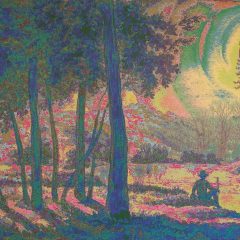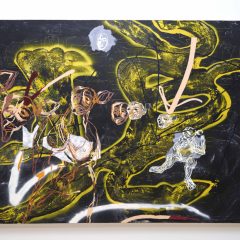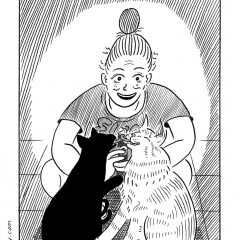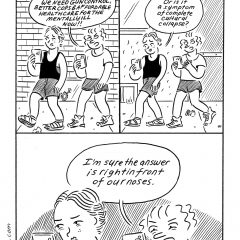Little Berlin’s group show, Forecast, places work by newly admitted members of the collective alongside pieces by founding members. As the press release notes, with a moderating dash of sarcasm: “Get a glimpse into the future through the artwork we make. Hence the clever title, FORECAST.” Indeed, the show gives a sense of what’s happening—some good, some still coming along—here in Philly.
New collective member Leslie Rogers’ video account of a mugging, “The Meeting,” is undoubtedly the highlight of the show.

A red-painted man with an intimidating mustache stands to the left. A blue-painted woman stands to the right. Red crosses the screen, menacing Blue. He pushes his head against hers and the camera zooms. Cut. They open their mouths. A small puppet of each figure stands on the tongues of the actors. The man’s puppet pulls a gun on the woman. Mouths close. Blue drops a few pennies into the hands of Red, and the video is over.
In “The Meeting” the puppets in the mouths—inanimate things—carry out the main action, while the literal bodies of the actors—the interiors of the mouths—become the stages. Rogers’ inversion of the typical relationship between actors and sets captures the logic of a mugging, where the participant’s material goods—a wallet and gun, respectively—have all the agency, while the participants bodies—an itchy trigger finger and pumping heart—become the sites where action might occur.
In founding member Robert T. Panell’s flash video, “Map of Stereotypes,” the formats of informational documents—history textbooks and PowerPoint-esque flash animated-graphics—are used to present information we typically try not to know. Panell’s map of America names the stereotype, rather than the place, associated with the geographic region corresponding to the position of the text. These words, animated, grow and shrink to showcase one stereotype at time. The word “Liberals” hovers over San Francisco, “Militants” over North Dakota, “Potatoes” over Idaho, and “Corn” over Iowa. The fact that most of us will recognize how these words might be applicable to those regions—regardless of whether or not we truly believe the meanings—forces us to feel a bit implicated in their continuation.

Rogers’ “The Meeting” and Panell’s “Map of Stereotypes” are slightly rough videos. While video, since the Porta Pak days, has had a proud tradition of DIY-aesthetics, these rough cuts feel particularly today and Philly. The strategy is often quite successful.
Founding member Beth Heinly’s work in Forecast takes us to another popular mode of contemporary art, the appropriation art, reconsidered. Heinly presents a piece of junk snail mail she received, taped to the wall, as a stand-alone piece: “Mail from the Internet.” It is not devoid of interest—the spammer seems to have mistaken her internet moniker “Berth Heiny,” for her real name. Moreover, the oddly convivial tone of the text—“Dinner Table For Berth Heiny and guest”—coming from impersonal spam mail is undoubtedly funny. Like stolen wifi, just out of range, Heinly’s piece almost ushers us into a web of associations, but fails to provide reliable connectivity.
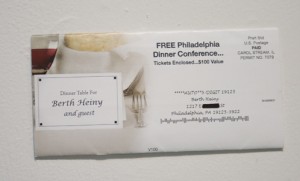
Another Heinly piece in the show is more made, but less ambitious in staking out new territory for art. “Fake Ray Bans” is a pair of light-colored Ray Ban style sunglasses that she painted black then painted the brand logo onto. The hand-done painting fools at 10 feet, but is crude enough to give away the process upon closer inspection. Like “Mail from the Internet,” “Fake Ray Bans” starts to suggest an interpretation: the now opaque painted-over lenses, aiming for “authenticity,” turn the cheap useable sunglasses into the functionless image of “real” ones. Striving for the authentic is truly a road to blindness, or something like that.

Ultimately, it is the choice of sunglasses, rather than the artist’s modifications, that carry the most visual impact. The Ray Ban style, made famous by 1960s American bohemians, but since turned into a global brand capitalizing on its former patronage, is, as its advertisements claim, iconic. Reading Heinly’s piece: (your)-cool-glasses-are-art-duh, rather than as a rehashed critique of authenticity, “Fake Ray Bans” comes off, somewhat for better, as flippant instead of stale.
Collective co-founder Martha Savery’s equally un-makerly piece “Laundry Configuration #4013, Things we won’t be wearing this summer” is more interesting, but feels unresolved. Savery took winter accoutrements and folded those clothes into basic piles at the back of the gallery.
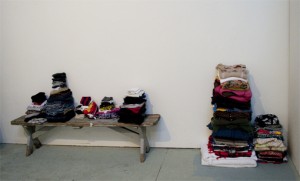
The idea of turning a quotidian experience or item into art through a change in location is a good one, but carries more impact when the relocated thing bears a stronger relationship to the place it is moved to or from. The laundry stacks, while pleasingly un-arty, do not go much further than that. Moreover, the improbable numeration “4013” adds a touch of art-object-fetish, the overall absence of which is the best part of Savery’s piece.
While the new, if still rough, takes on appropriation art in the work of Heinly and Savery as well as the deft narrative gestures of Rogers and Panell stood out to me in particular, there is lots of other art in Forecast. Work by new collective members Maria Dumlao and Kelani Nichole and continuing collective members Kristen Taylor, Alex Gartelmann, Sam Belkowitz, Masha Badinter, and Tyler Kline make Forecast, while a little mixed, well worth a visit. The show is open Saturday afternoons through July 10th.


